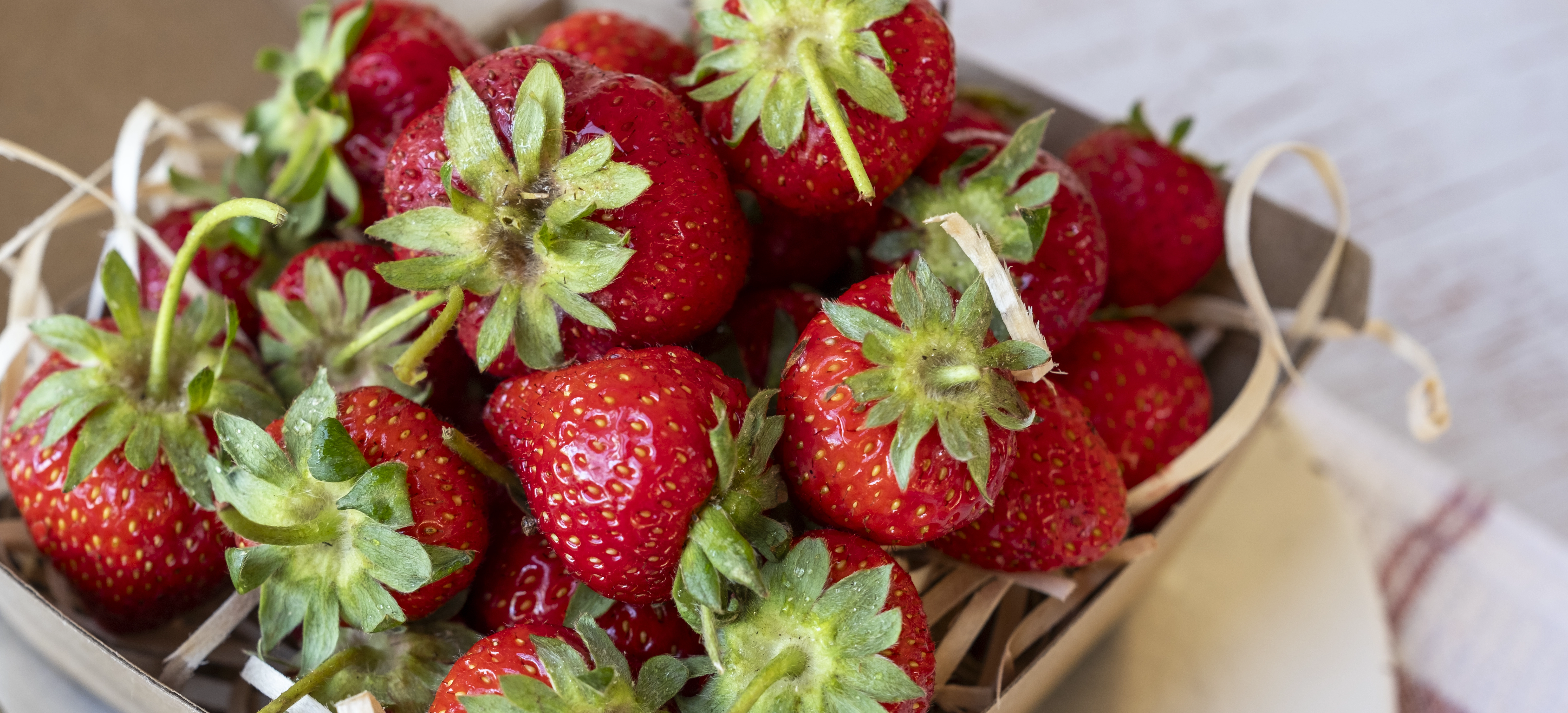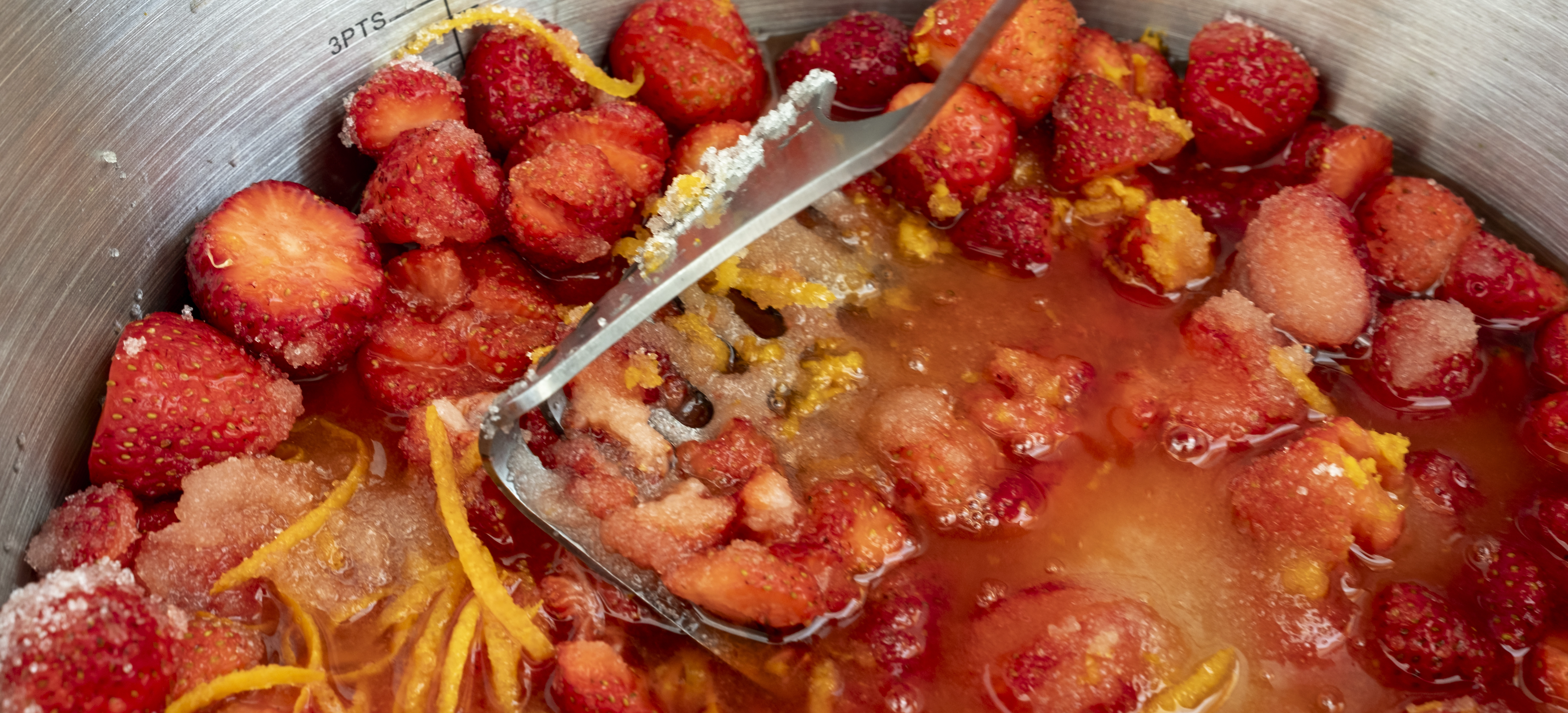Strawberry, Blood Orange & Grand Marnier Jam
- Jams, Jellies & Marmalades

Looking to jazz up your next batch of strawberry jam? Then this must be the one. The colour and flavour are intensified by the blood orange juice and the lingering hint of spice is mouthwatering. Make the most of the flush of spring strawberries and create an outstanding preserve that’s not bashful. Chunks of fruit, suspended in a citrusy softly set syrup is perfect to spread on toast or your favourite breakfast bread, pancakes, waffles, and even spooned over ice-cream. You’ll be surprised just how quickly it disappears.
- Preparation Time:
- 30 minutes
- Cooking Time:
- 20 minutes
- Quantity:
- 3 x 200 ml jars
PREPARATION
Warm dry sterilised sealable glass jars and lids.
Warm sugar

INGREDIENTS
- 500g
- Strawberries fresh, ripe
- 300g
- White sugar
- 2
- Blood Oranges, juice and rind
- 2
- Lemons, juice and rind
- 2 Tablespoons
- Grand Marnier Liqueur

METHOD
To rinse the strawberries, place in a colander, immerse in cold water and gently swirl. This will avoid fruit damage. Remove from the water and allow a few minutes to drain. Then remove the excess moisture by gently patting or allow to rest on paper towel or a clean dry tea towel.
Remove the green top (calyx) from the top of the strawberry. Some recipe books refer to this technique as “hulling the strawberries”. Using a small paring knife, remove any bruised, mouldy, or damaged parts of the fruit. Cut any large strawberries in half.
Use a micro plane to remove the rind from the lemons and blood oranges, then cut in half and juice. Remove the pips and discard.
Place the cleaned prepared strawberries, lemon and blood orange juice and rind and warmed sugar, into a large preserving pan or heavy bottomed stainless-steel pot.
Gently heat the mixture until the sugar is completely dissolved. Then bring to the boil quickly and boil rapidly.
While the jam is cooking, skim as required, using a sharp-edged spoon or ladle, to remove the scum that accumulates around the edge of the pot. Beware of hot spluttering jam – it can easily burn uncovered arms and hands.
Carefully stir occasionally to prevent the fruit from sticking to the bottom of the pot.
Just before the jam reaches its setting point or 105 degrees C (220 degrees F), add the Grand Marnier. It will splutter and the alcohol will evaporate off, leaving the intense orange flavour of the liqueur. Continue to rapidly boil until the setting point is reached.
Remove from the heat, place on a heat resistant surface and allow to sit for 5 minutes. If bottled immediately it’s likely the fruit will rise from the bottom of the jar.
Using a wide-necked funnel, ladle into warm sterilised jars, to within 2.5 cm (1 inch) from the top, distributing the fruit evenly between the jars.
Cover with sterilised lids, or with melted paraffin wax, while the jam is still hot. Label and store in a cool dark place in the kitchen or pantry.
Allow the jam to mature for at least 2 weeks before eating.
-
If sealing with wax, once it has set, cover with cellulose or plastic film and secure with a rubber band or string. Refer to the Notes section below for more detailed instructions on sealing with paraffin wax. Alternatively allow jam to cool completely and seal with a screw top lid.
The hot method of sealing is preferred as there is reduced risk of contamination prior to sealing. A vacuum seal will also be created as the jam cools down when the lid is screwed on tightly.
NOTES
- Strawberries have a low pectin and acid content and requires the addition of lemon juice to produce a set. Refer to my post, What Makes Jam, Jelly and Marmalade Set, to understand how preserves set. It also contains a handy Acid and Pectin Chart so you can get even your most creative combinations to set.
- Choose ripened clean strawberries. Do not use overripe and never use mouldy fruit as this will produce a poor-quality jam.
- If you don’t have a preserving pan, use a large heavy bottom pot, preferably stainless steel. This will distribute the heat evenly across the base and the jam while it is cooking. Ensure there is enough space available in the pot for the mixture to double in size while it is rapidly boiling.
- To warm the sugar, put the recipe quantity in an oven proof container and place in a preheated oven to 150 degrees C for approximately 10 minutes. The sugar should be warm throughout the bowl. Warmed sugar dissolves quickly and then boiling rapidly until the setting point is reached helps to preserve the fresh fruit flavour.
- Ensure the sugar has completely dissolved before boiling otherwise the sugar may crystallise later in the jar.
- Rapidly boil the jam until it reaches the setting point, stirring occasionally to prevent the jam from sticking on the bottom of the pot. But not too often as this will lower the temperature and delays reaching the setting point. Long slow simmering at this point will reduce the colour and flavour.
- If for some reason, a jam doesn’t set don’t discard it. It can either be re-boiled to reach its setting point or used as a delicious sauce to accompany cake, dessert or spooned lovingly over ice-cream.
- Cooking times are an approximation only. They are provided as a guideline as cooking times are influenced by the type of pot and its diameter and height, speed of cooking and fruit ripeness, size, and moisture level.
- Removing the scum
- Jam, jellies, and marmalades can produce a scum while they are boiling. Impurities from the fruit and sugar will rise to the surface and a fine frothy foam will move towards the edge of the preserving pan. Some fruits will produce more scum than others.
- This is a natural self-clarification process and makes the task of making a high-quality preserve easier. Removing it increases the preserve’s clarity. This is important if it is being submitted for competition. To remove the scum before bottling. Using a stainless-steel spoon, skim the scum from around the edge of the preserving pan. Be careful to remove just the scum and not the jam. This can be done while the jam is boiling and/or once it has been taken off the heat. Do not attempt to remove it from the centre of the boiling jam, as there is an elevated risk the jam will splutter and hot jam burns.
- Using paraffin Wax
- Paraffin wax is available in speciality preserving stores and some rural hardware stores.
- The melted wax must be poured over the preserve while it is hot.
- To melt the wax break into small pieces and heat in a bowl set over a pan of hot water. Bring the water to the boil, reduce the heat to maintain a gentle simmer until the wax is just melted.
- Do not overheat. If it gets too hot it will shrink away from the sides of the preserving jar as it cools. This will break the seal and allow impurities to access the contents, encouraging mould growth.
- Working quickly pour a thin layer over the hot preserve. Using a small wooden cocktail stick, toothpick, or cake skewer, prick any air bubbles.
- Allow the wax to set. Then pour a second thin layer to make a seal approximately 3mm thick.
- When the wax has set it will become opaque and dip slightly in the middle.
- To use the preserve, break the wax seal and remove.
- Cover the jar with clear film and store in the fridge.
- Sealing with wax is not a long-term solution. Use within a couple of months.
- Variations: Try a combination of soft berries to create a delicious mixed berry jam. The lemon juice is an essential ingredient as berries are low in pectin and acid and the lemon juice will help it to set.
- Grand Marnier: It’s an orange flavoured liqueur which is made from a mixture of French cognac and a blend of bitter orange fruits. If you don’t have any available substitute with Cointreau, a good quality orange liqueur or better still your own home-made orange liqueur.
